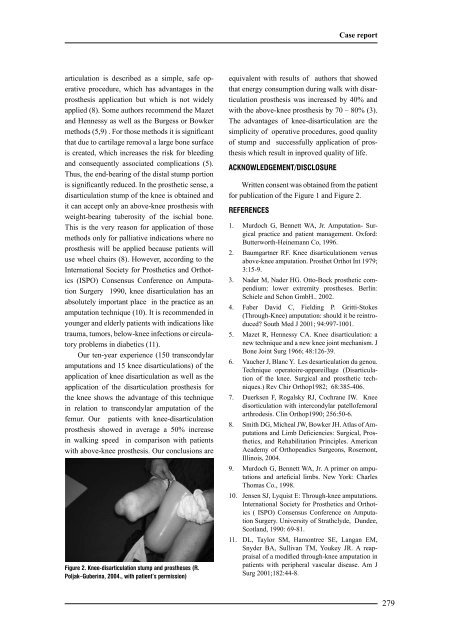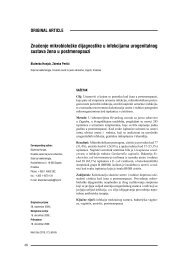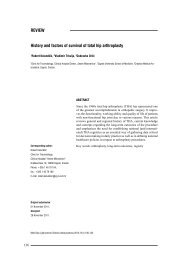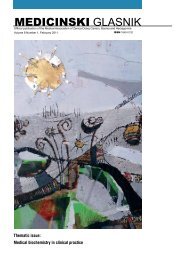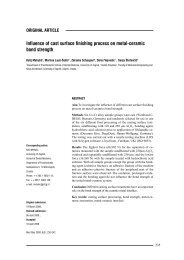MEDICINSKI GLASNIK
MEDICINSKI GLASNIK
MEDICINSKI GLASNIK
You also want an ePaper? Increase the reach of your titles
YUMPU automatically turns print PDFs into web optimized ePapers that Google loves.
articulation is described as a simple, safe operative<br />
procedure, which has advantages in the<br />
prosthesis application but which is not widely<br />
applied (8). Some authors recommend the Mazet<br />
and Hennessy as well as the Burgess or Bowker<br />
methods (5,9) . For those methods it is significant<br />
that due to cartilage removal a large bone surface<br />
is created, which increases the risk for bleeding<br />
and consequently associated complications (5).<br />
Thus, the end-bearing of the distal stump portion<br />
is significantly reduced. In the prosthetic sense, a<br />
disarticulation stump of the knee is obtained and<br />
it can accept only an above-knee prosthesis with<br />
weight-bearing tuberosity of the ischial bone.<br />
This is the very reason for application of those<br />
methods only for palliative indications where no<br />
prosthesis will be applied because patients will<br />
use wheel chairs (8). However, according to the<br />
International Society for Prosthetics and Orthotics<br />
(ISPO) Consensus Conference on Amputation<br />
Surgery 1990, knee disarticulation has an<br />
absolutely important place in the practice as an<br />
amputation technique (10). It is recommended in<br />
younger and elderly patients with indications like<br />
trauma, tumors, below-knee infections or circulatory<br />
problems in diabetics (11).<br />
Our ten-year experience (150 transcondylar<br />
amputations and 15 knee disarticulations) of the<br />
application of knee disarticulation as well as the<br />
application of the disarticulation prosthesis for<br />
the knee shows the advantage of this technique<br />
in relation to transcondylar amputation of the<br />
femur. Our patients with knee-disarticulation<br />
prosthesis showed in average a 50% increase<br />
in walking speed in comparison with patients<br />
with above-knee prosthesis. Our conclusions are<br />
Figure 2. Knee-disarticulation stump and prostheses (R.<br />
Poljak–Guberina, 2004., with patient’s permission)<br />
equivalent with results of authors that showed<br />
that energy consumption during walk with disarticulation<br />
prosthesis was increased by 40% and<br />
with the above-knee prosthesis by 70 – 80% (3).<br />
The advantages of knee-disarticulation are the<br />
simplicity of operative procedures, good quality<br />
of stump and successfully application of prosthesis<br />
which result in inproved quality of life.<br />
ACKNOWLEDGEMENT/DISCLOSURE<br />
Written consent was obtained from the patient<br />
for publication of the Figure 1 and Figure 2.<br />
REFERENCES<br />
Case report<br />
1. Murdoch G, Bennett WA, Jr. Amputation- Surgical<br />
practice and patient management. Oxford:<br />
Butterworth-Heinemann Co, 1996.<br />
2. Baumgartner RF. Knee disarticulationem versus<br />
above-knee amputation. Prosthet Orthot Int 1979;<br />
3:15-9.<br />
3. Nader M, Nader HG. Otto-Bock prosthetic compendium:<br />
lower extremity prostheses. Berlin:<br />
Schiele and Schon GmbH., 2002.<br />
4. Faber David C, Fielding P. Gritti-Stokes<br />
(Through-Knee) amputation: should it be reintroduced?<br />
South Med J 2001; 94:997-1001.<br />
5. Mazet R, Hennessy CA. Knee disarticulation: a<br />
new technique and a new knee joint mechanism. J<br />
Bone Joint Surg 1966; 48:126-39.<br />
6. Vaucher J, Blanc Y. Les desarticulation du genou.<br />
Technique operatoire-appareillage (Disarticulation<br />
of the knee. Surgical and prosthetic techniques.)<br />
Rev Chir Orthop1982; 68:385-406.<br />
7. Duerksen F, Rogalsky RJ, Cochrane IW. Knee<br />
disorticulation with intercondylar patellofemoral<br />
arthrodesis. Clin Orthop1990; 256:50-6.<br />
8. Smith DG, Micheal JW, Bowker JH. Atlas of Amputations<br />
and Limb Deficiencies: Surgical, Prosthetics,<br />
and Rehabilitation Principles. American<br />
Academy of Orthopeadics Surgeons, Rosemont,<br />
Illinois, 2004.<br />
9. Murdoch G, Bennett WA, Jr. A primer on amputations<br />
and arteficial limbs. New York: Charles<br />
Thomas Co., 1998.<br />
10. Jensen SJ, Lyquist E: Through-knee amputations.<br />
International Society for Prosthetics and Orthotics<br />
( ISPO) Consensus Conference on Amputation<br />
Surgery. University of Strathclyde, Dundee,<br />
Scotland, 1990: 69-81.<br />
11. DL, Taylor SM, Hamontree SE, Langan EM,<br />
Snyder BA, Sullivan TM, Youkey JR. A reappraisal<br />
of a modified through-knee amputation in<br />
patients with peripheral vascular disease. Am J<br />
Surg 2001;182:44-8.<br />
279


